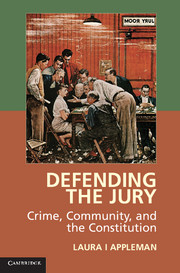Book contents
- Frontmatter
- Contents
- Acknowledgments
- 1 Introduction
- Part I History in the Crucible: Rediscovering the Original Community Right in Criminal Justice
- Part II Old Becomes New: Sixth Amendment Jury Rights and Twenty-First-Century Criminal Procedure
- Part III Theory into Practice: Origins and Community in Modern Criminal Procedure
- 6 Bail, Jail, and the Community Voice
- 7 Infusing Community through Criminal Procedure: The Plea Jury
- 8 Eradicating the Bench Trial
- 9 Restoring the Offender to Society
- 10 Back-End Sentencing: The Sixth Amendment and Post-Prison Procedures
- 11 Jury Nullification and Victim Rights: Going Past Procedure
- 12 Conclusion
- Selected Bibliography
- Index
- References
10 - Back-End Sentencing: The Sixth Amendment and Post-Prison Procedures
Published online by Cambridge University Press: 05 April 2015
- Frontmatter
- Contents
- Acknowledgments
- 1 Introduction
- Part I History in the Crucible: Rediscovering the Original Community Right in Criminal Justice
- Part II Old Becomes New: Sixth Amendment Jury Rights and Twenty-First-Century Criminal Procedure
- Part III Theory into Practice: Origins and Community in Modern Criminal Procedure
- 6 Bail, Jail, and the Community Voice
- 7 Infusing Community through Criminal Procedure: The Plea Jury
- 8 Eradicating the Bench Trial
- 9 Restoring the Offender to Society
- 10 Back-End Sentencing: The Sixth Amendment and Post-Prison Procedures
- 11 Jury Nullification and Victim Rights: Going Past Procedure
- 12 Conclusion
- Selected Bibliography
- Index
- References
Summary
A criminal offender’s sentence does not end upon the completion of the term of imprisonment, of course. A modern sentence includes all the various aspects of supervision the offender must undergo, including parole, post-release supervision, and restitution. Upon a prisoner’s release, the terms of her probation and supervised release, initially determined by the state legislature and imposed by the court, are enforced and regulated by parole officers. The trial court or the parole officer collects the amount of restitution, imposed during sentencing, after the sentencing hearing. This system of back-end sentencing, however, has long been obscured from public view. It is these types of sentencing proceedings, which can increase the length and the burden of an offender’s sentence, that must also be considered through the lens of the community jury trial right.
The first question to address when thinking about the world of post-prison procedures is whether post-release supervision should be subject to the community jury trial right. Most criminal sentences include a period of supervised release following the completion of the imposed sentence. Violating this condition can result in revocation of the conditional release and sometimes can even lengthen the duration of the original prison term. The trial or magistrate judge determines whether supervised release has been violated, using some minimum level of procedural due process, with the facts provided by a probation officer or the department of corrections.
- Type
- Chapter
- Information
- Defending the JuryCrime, Community, and the Constitution, pp. 191 - 209Publisher: Cambridge University PressPrint publication year: 2015



